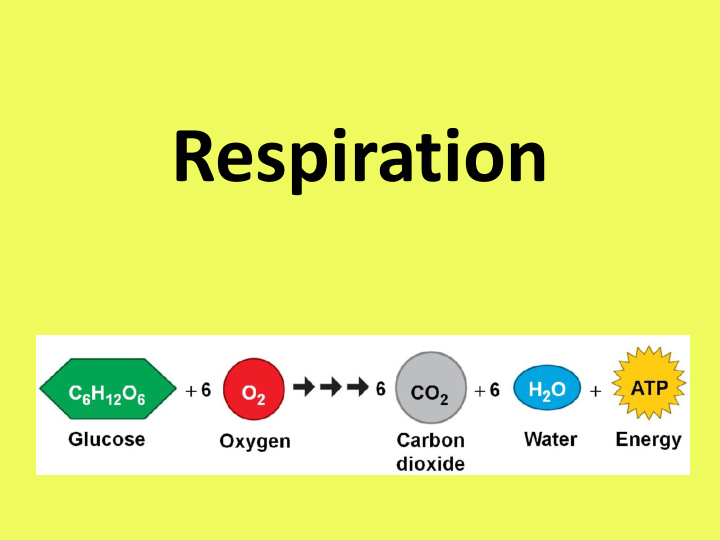



Respiration
What is the purpose of respiration?
Terms to Know • Reduced – gains electrons (RIG) • Oxidized – loses electrons (OIL) • H + - hydrogen ion or proton • NAD • FAD • Substrate Level Phosphorylation • Oxidative Phosphorylation • Chemiosmosis • Proton-motive force
Mitochondria
Cellular Respiration Overview
Cellular Respiration Overview • Occurs within the cytosol and mitochondria of cells • Yields up to 32 to 34 ATP molecules per glucose molecule • Three steps: 1. Glycolysis 2. Krebs Cycle 3. Electron Transport Chain
Cellular Respiration Equation C 6 H 12 O 6 + 6O 2 6CO 2 + 6H 2 O + ATP • Redox Reaction : movement of electrons from one molecule to another • Electrons lose potential energy as they move, and energy is released
Cellular Respiration Summary
Cellular Respiration Overview
First Step: Glycolysis
Substrate-Level Phosphorylation
First Step: Glycolysis • Glucose is oxidized into two molecules of pyruvic acid (or pyruvate) • Occurs within the cytosol of cells • 2 ATP molecules are produced as well as 2 NADH molecules • NAD+ is an electron “shuttle”
Second Step: Krebs Cycle
Second Step: Krebs Cycle • Occurs within the mitochondrial matrix • Pyruvic acid is first oxidized to produce CO 2 and 2 additional ATP molecule resulting in a highly reactive compound called Acetyl-CoA • Electron carrier molecules NADH and FADH 2 are produced – transfer electrons (energy) to the electron transport chain
Third Step: Electron Transport Chain
Third Step: Electron Transport Chain • Occurs within the inner mitochondrial membrane • High energy electrons ( transported by NADH and FADH2 molecules ) enter the electron transport chain and release energy as they pass from one carrier molecule to the next
Third Step Continued: Electron Transport Chain • The energy released is used to combine inorganic phosphate to ADP produce 26-28 additional ATP molecules ( oxidative phosphorylation ) • Oxygen molecules serve as the final electron acceptor due to its electronegativity • Hydrogen ions (H + ) combine with oxygen to produce H 2 O (water)
Cellular Respiration Summary
Fermentation • Begins with glycolysis • Purpose of fermentation is to regenerate NAD+ from NADH to drive glycolysis (no glycolysis = cell death) • Two types: lactic acid fermentation and alcoholic fermentation
Lactic Acid Fermentation • Occurs in animals in times of oxygen debt (i.e. strenuous exercise and some bacteria
Alcoholic Fermentation • Occurs in bacteria and yeast
Recommend
More recommend